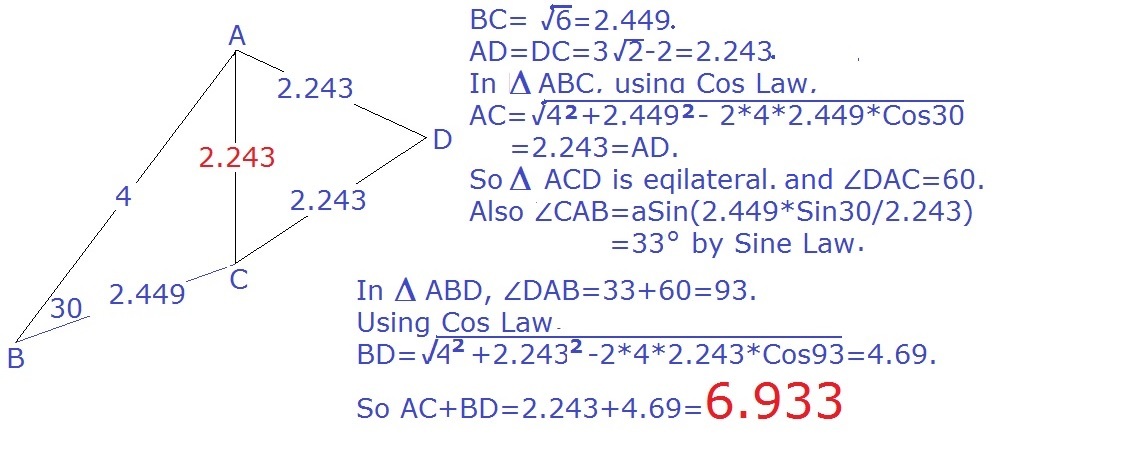Mysterious Quadrilateral
A B C D is a quadrilateral that A B = 4 , B C = 6 , C D = D A = 3 2 − 2 , ∠ B = 3 0 ∘ .
What is the sum of the length of the 2 diagonals?
The answer is 6.933.
This section requires Javascript.
You are seeing this because something didn't load right. We suggest you, (a) try
refreshing the page, (b) enabling javascript if it is disabled on your browser and,
finally, (c)
loading the
non-javascript version of this page
. We're sorry about the hassle.
3 solutions
By the law of cosines on triangle ABC, we get that A C = 3 2 − 2 = C D = D A , so ACD is equilateral.
Let the perpendicular to BC at C hit AB at E; then BCE is a 30-60-90 triangle, and C E = 2 . Also, A E = 4 − 2 2 , and ∠ C E A = 1 2 0 .
We can then use the law of cosines and sines on ACE to get the sine and cosine of ∠ A C E . Since we have ∠ B C E = 9 0 , ∠ A C D = 6 0 , we have ∠ B C D = ∠ A C E + 1 5 0 . Then we use the cosine addition formula to compute the cosine of ∠ B C D , and by the law of cosines on triangle BCD we find that B D = 2 2 .
The answer is then just 3 2 − 2 + 2 2 ≈ 6 . 9 3 3 .
Submitted superb
Let the diagonal AC be denoted by P. Then, in triangle ABC, by the Law of Cosines, P^2 = 4^2 + [sqrt(6)]^2 - 2 4 sqrt(6) cos(30(, or P = 2.242640687. Define < BAC = t. then, by the Law of sines, sqrt(6)/sin(t) = P/sin(30). Substituting, t = 33.10104895. Define < CAD = a. Then, in triangle ACD, by the Law of sines, P/sin(180 - 2a) = (3sqrt(2) - 2)/sin(a), or P/sin(2a) = 2.242640687/sin(a), or P/(2sin(a)cos(a) = P/sin(a). or cos(a) = .5, and a = 60. Then t + a = 93.10104895. Defining the diagonal BD as Q, in triangle BAD, we have by the Law of cosines, Q^2 = 4^2 + (3sqrt(2) - 2)^2 - 4 (3(sqrt(2) - 2)cos(93.10104895. Then Q = 4. 690415761, and P + Q = 6.932. Ed Gray
